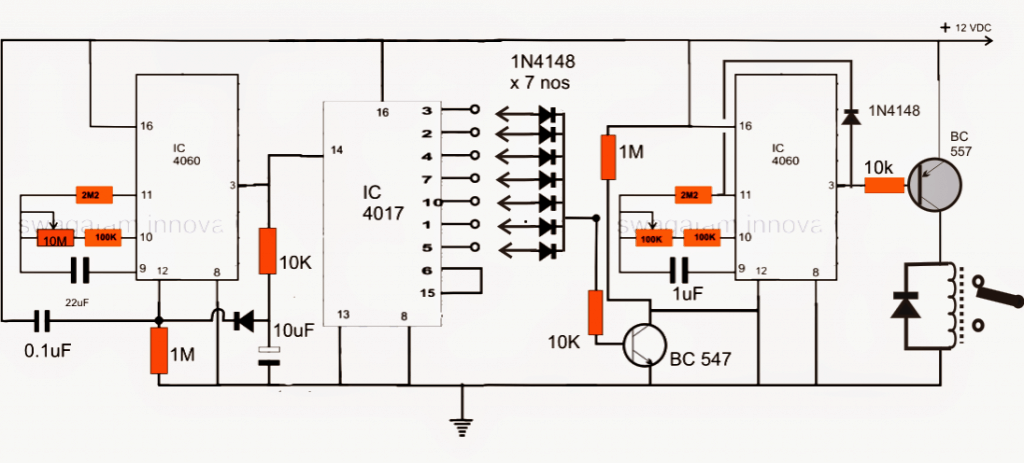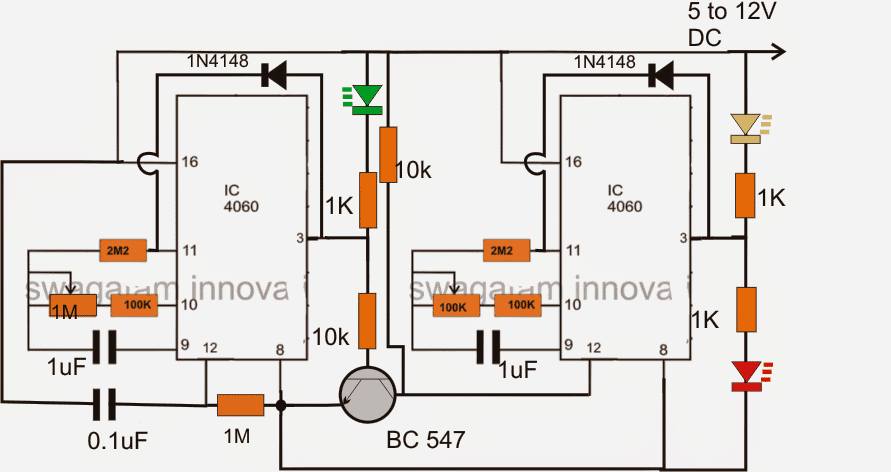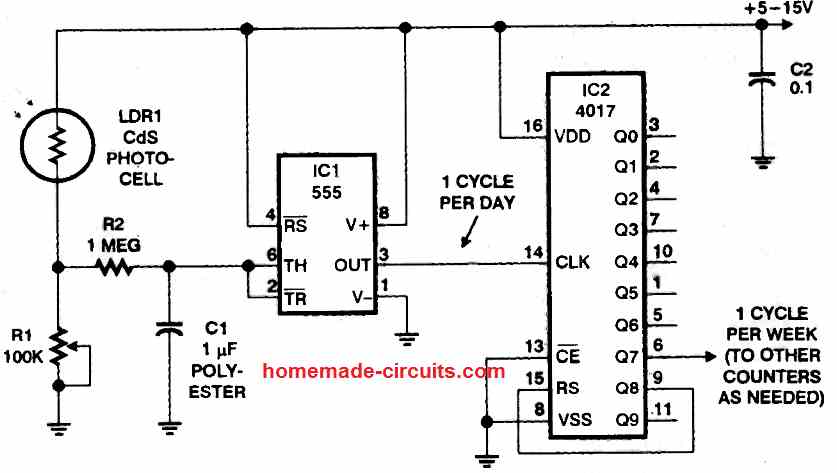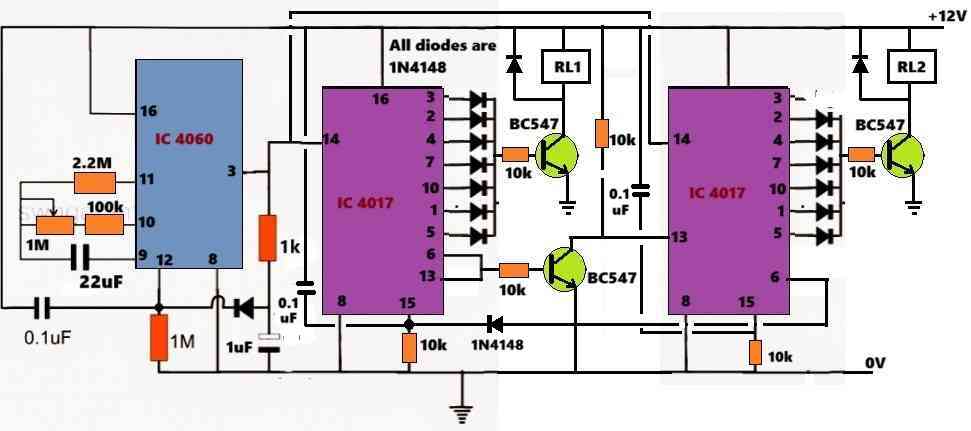In this post I have explained a couple of interesting timer circuits customized as per individual requirements.
The first one is a kind of week/day programmable timer circuit for actuating a motor for a predetermined time only during certain selected days of the week, while the second timer circuit is for alerting a lecturer regarding the finish of the allotted time of his/her class period.
The ideas were requested by Mr. Stevan and Mr Ilman respectively.
Circuit Request#1
I spend more than 20 hours on your site, searching for a circuit I need...
My knowledge is not enough to figure which circuit I can use and I tried with many of them... If you have time, I would be very grateful if you could help me and design circuit.
I need timer circuit which will allow me to choose for how long it will stay ON (3-10 sec) and how many times it will repeat that action during 7 days (1-7 times i.e. once in a week, twice in a week, every day etc). I need it for controlling 9-12V electrical motor.
Circuit Diagram

Circuit Operation
As shown in the above week day programmable timer circuit, the IC 4060 at the left side is wired up as a 24 hour timer circuit.
The time length is determined by the 22uF capacitor and the 10m pot. A suitable fixed value may be selected for these two components for getting the specified time delay.
The 22uF capacitor must be non-polar low leakage type of capacitor and the resistors should be MFR 1%
The output is received from pin#3 of the above IC, which goes high as soon as the set time elapses. This results in a short pulse to pin#14 of the IC 4017 which is configured as a 7 stage counter divider here.
With every pulse after the preset 24 hours interval, the IC 4060 also resets itself via the diode connected across its pin#3 and pin#12.
The IC 4017 output functions as a week timer where its 7 outputs shift (become high) from pin3 to pin6 sequentially in response to the above 24 hour pulses, depicting the 7 days of the week.
The right hand side IC 4060 is configured as short duration timer for activating the motor which may be connected with the shown relay contacts.
This stage is integrated with the IC 4017 stage through the shown 7 1N4148 diodes. Depending on what days the motor needs to be switched ON, only those relevant diodes are connected with the 4017 outputs, rest of the diodes are kept unconnected.
After all these connections, when power is switched ON, the left hand side 4060 triggers and forces the outputs of the IC 4017 to become high in sequence every after 24 hours.
Depending upon the connections of the diodes, the right hand side 4060 IC gets switched ON only on those selected days of the week via the BC547 transistor which grounds its reset pin#12 on receiving the signal from the IC 4017 relevant outputs.
This prompts its pin#3 to go low activating the preceding relay driver stage and the motor.
The above stage stays activated until the set time elapses when its output becomes high inhibiting the relay driver sage from base drive thereby stopping the motor.
The high from the pin 3 also latches the IC via the diode to its pin11. The time interval may be fixed by adjusting the given 100k pot
The whole operation resets on the next pulse from the 24 hour 4060 timer stage.
The operation thus repeats as per the programming done on the three ICs.
Circuit Request#2
I need circuit for time limiter to use for public speaking.
Say if a teacher has one hour to speak in the class then the timer will show a green light starting from 60 minute then counting down to 0, but before finish the yellow light will turn on to remain a teacher that the time almost finish, it can be 3 minutes before to 0, finally when the time is over the red light will be on, it means that time for the teacher is finish.

Circuit Operation
The above cascaded two stage sequential timer circuit is rather simple with its configuration Two 4060 ICs are linked with each other to form a sequential timer configuration.
The left IC is rigged as a 57 minute timer circuit while the right hand side IC as a 3 minute timer circuit.
When switched ON the left IC starts counting (green LED ON) until 57 minutes have elapsed which makes its pin3 go high, shutting off the green LED
This triggers the connected BC547 transistor which now grounds pin12 of the second 4060 IC prompting it to start its 3 minute counting process.
This activates the yellow LED indicating the last 3 minutes being counted, until it gets over shutting off the yellow LED and switching ON the RED LED.
The diodes across pin3 and pin11 of the ICs keep the ICs latched until the circuit is switched OFF and switched ON for initiating the next cycle.
Using LDR for Detecting Day Night Periods
The fundamental strategy is to produce an electronic signal that turns high once the sun sets and turns low as dawn sets in, followed by counting the transitions. Photocel1 LDR1 is positioned to sense the sun light.
This must be targeted at the north skies instead of the sun directly, thus it is going to see practically the same thing during clear skies and also over cast ones.
R1 is placed for controlling sensitivity of the LDR.

A good way to fine-tune it, without dealing with a complete day/night period, is to hold off until around 10 minutes following sunset, at the center rotation between day and night, and alter R1 in order that the voltage across it is half the supply voltage.
Later, examine that the IC1 output is high during night and low during the daytime. A low-pass filter is created using R2 and C1, producing roughly a 1-second hold up to ensure the circuit doesn't get rattled with lightning flashes or various other brief light variations.
A 555 timer, ICI, is employed like a light level sensor; instead of the comparator circuit. The 555 offers hysteresis, which implies that the trigger ON voltage will be greater than the trigger-off voltage.
This prevents the circuit from "stuttering" to and fro between off and on during transition thresholds. The second IC in the circuit (IC2) is a 4017 (CD4017) CMOS decade counter.
Simply by hooking up output Q8 to the reset input, we allow it to count upto 7 and then start off yet again, therefore its output creates a solitary day-long pulse each week. You are able to supply this to additional counters in order to calculate even extended time periods.
For instance, incorporating a divide-by-four counter (like a 4017 with Q5 attached to reset) could give you a period of 28 days.
7 Day ON and 7 Day OFF Timer Circuit
The following circuit will keep relay#1 switch ON for 7 days, and when relay#1 is switched OFF after 7 days, relay#2 is switch NN for the next consecutive 7 days. This alternate 7 day ON and 7 day OFF across relay#1 and relay#2 is maintained infinitely, as long as the circuit remains powered ON.
